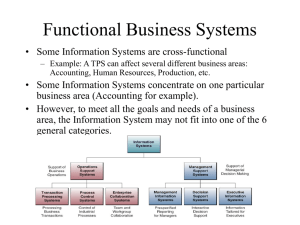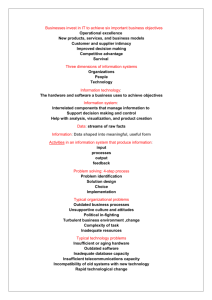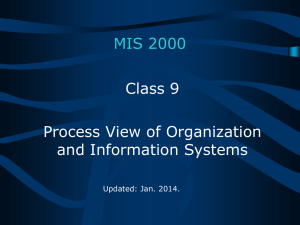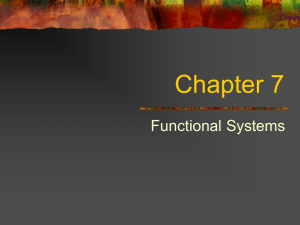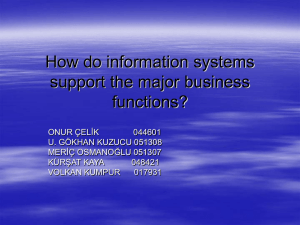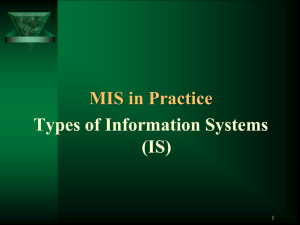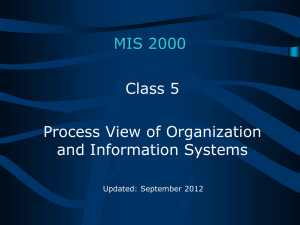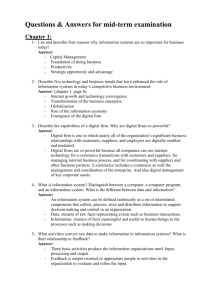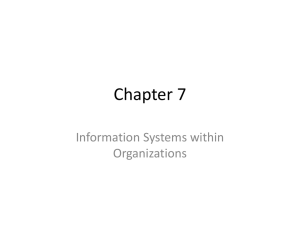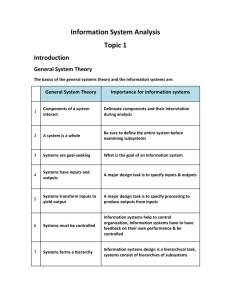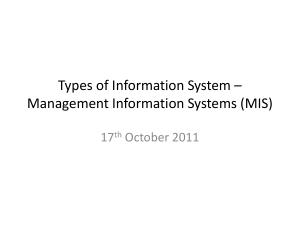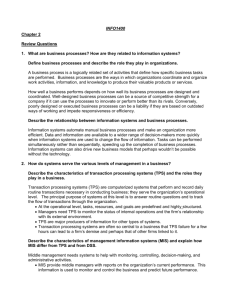Process View of Organization and Information Systems
advertisement
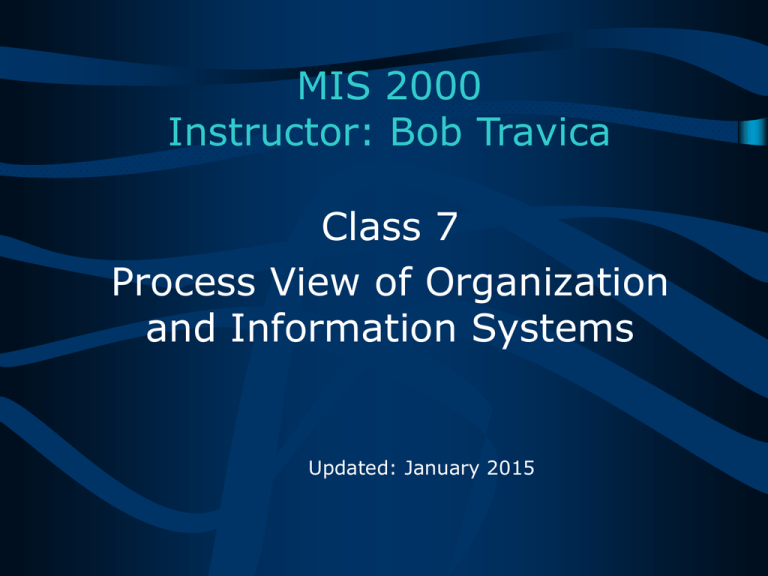
MIS 2000 Instructor: Bob Travica Class 7 Process View of Organization and Information Systems Updated: January 2015 Outline • Cases of IS roles in business processes (expanding over Chapter 5) – IS impacts on process design optimization – Impacts of process design on process performance • Typologies of information systems • Summary 2 DESIGN OPTIMIZER ROLE PERFORMANCE BOOSTER ROLE Information System Technological Properties BUILDING BLOCK ROLE • Recalling from the last lecture, IS has three roles in business processes: – Technological characteristics of IS make the building block in process design – IS Functionality makes IS the process optimizer – Non-functional characteristics of IS are the process performance booster Focus in this lecture is on relationships marked with yellow arrows: Process Performance Process Design Organizational Performance Information System • IS and Process Design • Process design and Process Performance IS and Process Composition IS can help to optimize Process Composition. IS can influence the selection of activities, performers (workers), departments, and organizations to be included in a process. • • Example: A new Purchasing TPS implemented at Ford made its purchasing order process: different work activities than those used before. Example: A computer network linking information systems at Kia and service shops in support to inter-organizational quality control process. 5 IS and Process Complexity IS and Process Complexity: IS can absorb complexity or simplify process a process looking from the perspective of process performers. The number of manual steps is reduced. This is possible because IS performs some activities and decisions instead of people (automation). • Example: A Decision Support System performs very complex calculations so that a decision maker is spared of such steps – decision process looks simpler. 6 IS and Process Coordination IS and Process Coordination: IS can enhance coordination among the process activities and process performers. • • Example: The supply process at Walmart uses inventory management systems linked via a corporate network; data transfer across supply chain between Walmart stores, Walmart distribution centres, and suppliers. Group decision making process that includes a GDSS makes it possible for decision makers to brainstorm in parallel rather than in sequence. IBM was a big user of GDSS. Facilitator drives the session Decision makers 7 IS and Process Design - Flexibility IS and Process Flexibility: IS can contribute to controlling variation in a process. Think of variation in terms of availability of options (usually desirable), and deviation from a benchmark (usually undesirable). Example A: Various reservation processes (hotel, travel, university course) could be done with the start activities supported by different technologies (telephone, cell phone, Website, email). The process has several versions. Example B: The quality control process in manufacturing rests on controlling variation between a part under production and desired benchmarks (size, etc.). Today, quality control process is automated and IS continuously inspect and report on the state of production. 8 Process Design and Process Performance Based on cases discussed so far: Process Design Aspect Impacted by IS Process Performance Aspect Time Cost Customer Value Composition improvement Savings in process time at Ford Labor reduced at Ford Quality improved at Kia Complexity reduction Savings in decision making process Fewer people needed for calculations Better decisions Coordination improvement - Efficiencies in Walmart’s supply chain Price of saved labor hours (cost avoidance) - Satisfied partners in Walmart supply chain - Savings in meeting time with GDSS - Shorter meetings, reduced opportunity cost - Better ideas for mgmt. Automated quality control in car production streamlined Waste reduction due to better quality control Flexibility - Product quality gains 9 Typologies of Information Systems Time Focus Information systems studied in this course: • • • • • • • • Transaction Processing system (TPS) Management Information System (MIS) Decision Support System (DSS) Knowledge Work System (KWS) Group Support System (GSS) Communication Systems Office Automation System (OAS) Enterprise Resource Planning System (ERPS) Typologies show similarities and differences between these systems looking from different angels. 10 Typologies of Information Systems: Organizational Function & Time Focus • Based on Org. Function: - Production system - Accounting IS - HRIS - Sales system… - Usually TPS & MIS • Different data content – look back at schemas for different business domains • Based on time focus: • Past/present focused: – Supporting & recording current operations – Reporting on the past business • Future focused – Planning, predicting – Longer range decision making Past Now TPS, MIS Future DSS 11 Typologies of Information Systems (IS): User Focus Different systems serve different groups of users. System types have different level of detail, processing capabilities, and outputs. Executive Management Management Information System (MIS) - Mid-range performance control & planning Mid-level Management Transaction Processing system (TPS) - Daily operations control Supervisory Management Knowledge Work Systems (professionals) Decision Support System (DSS) - Strategic decision making Group Support Systems (any teams) Communication Systems (everybody) Office Automation Systems (clerks, others) 12 Typology of Information Systems: Cross-referencing • Relationship between IS types based on org. function and management user groups: Organizational Function-based IS User-based IS Type Human Resources IS (HRIS) TPS MIS DSS Management Level Supervisory Middle Executive Database of travel claims with some queries Atop TPS; more queries and reports with aggregate travel expenses for longer periods Atop MIS; aggregate annual figures, and projecting future expenses and budget needs 13 Summary • IS can help to optimize process design (Composition, Complexity, Coordination, Flexibility) • Improvements in process design reflect in process performance (Customer Value, Cost, Time) • IS types can be differentiated on the bases of organizational function, time, and user group. • IS types serving management groups are TPS, MIS and DSS. • IS typologies can be cross-referenced (same system shown as different types). 14
